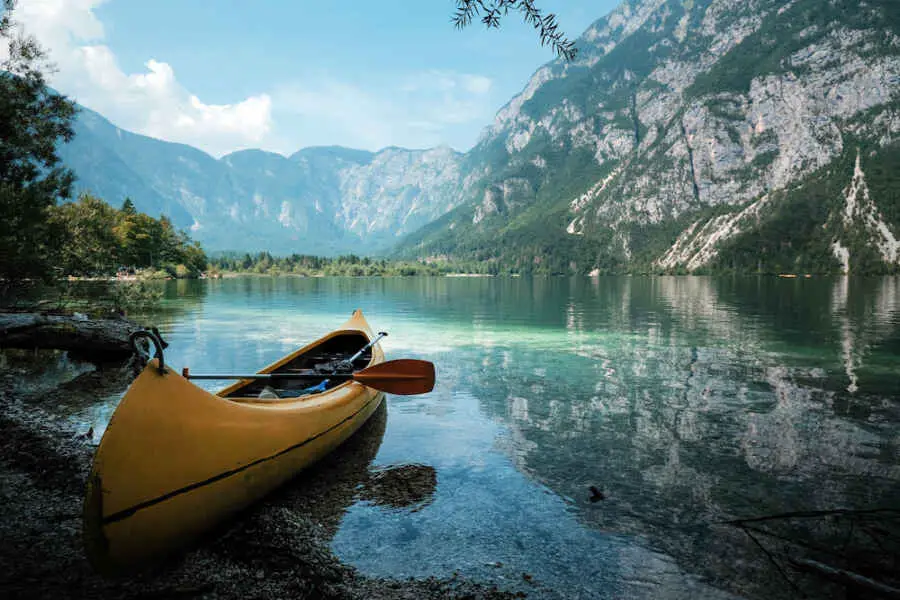Canoe vs kayak, which one is best suited for you?
To know that, you first need to understand each one of them and also know the differences between canoeing vs kayaking.
Right off the bat, you will find a ton of similarities between the two.
For example, they’re both waterborne vessels that have been used for thousands of years.
They also both come with paddles and prevent you from taking an untimely and unwelcome bath in water.
With so many similarities, are there any differences between the two?
Even though several people tend to use these two words interchangeably, there is a clear distinction between a canoe and a kayak.
They both have different gears; the vessels themselves have a number of differences, even their history is quite different, and that’s what we aim to shed light on today.
Canoe vs Kayak
Before we can even talk about the differences between the canoe and kayak, we must talk about what they each are.
What Is a Kayak?
Kayaks are a type of boat. They often tend to be small and slim and are either used by a limited number of people or by a single person.
There are many different kayaks on the market, and each of their designs differs based on their usage.
If classified broadly, the major types of kayaks include fishing, leisure, surf play, and tour kayaks.
What Is a Canoe?
Canoes are shaped similarly to the kayak, but the major difference is that they aren’t enclosed.
The canoe is completely open and can carry multiple people at a time. It is known for being quite sturdy as it can withstand white waters.
Canoes are often used for attracting tourists and for sightseeing purposes.
Brief History of Canoes and Kayaks
Below are some important facts as to how canoes and kayaks came about.
Canoes
The word canoe comes from the Carib kenu (dugout), from the Spanish canoa.
If you think about it, the name makes a lot of sense, and indeed, a dugout canoe is still an alternative name for a canoe, especially one that is made out of a hollowed tree trunk.
One of the earliest canoes discovered is the Pesse canoe. It can be dated back to 8200 BC and was found in the Netherlands.
It is the oldest canoe ever found and the oldest known boat in the world.
The indigenous people of America were also known for their canoes.
When the Europeans started exploring the Americas in the 14th, 15th, and 16th centuries, they were quite impressed with the designs of these canoes.
This is what led the canoe to play such an important role in European exploration, particularly in the interior of North America.
Kayaks
Kayaks can be traced back to the Inuit tribes in Canada, Greenland, and Alaska.
These were typically used for hunting and made out of wood with seal skin stretched over for an enclosed top.
It was the Scandinavian explorers who took up kayaking later and made it so popular in Europe.
Canoeing and Kayaking
In the early 20th century, canoeing was featured as a demonstration sport at the 1924 Olympic Games.
Over a decade later, at the infamous Olympic Games of 1936, since Adolf Hitler’s Nazi Germany hosted it, canoeing became a full Olympic sport.
There were about nine games, all in the canoe sprint that were held that year. Only men were allowed to participate in all of these games.
It was only 12 years after that kayaking and canoeing both entered the Olympics as a women’s sport.
We have come a long way since then. Even the materials used to make canoes and kayaks differ.
These days you will find materials such as rotomolded polyethylene used commonly to make them.
The biggest benefit of this material is that it is quite cheap, highly flexible, and resistant.
Fiberglass is another common material used to make canoes and kayaks.
These tend to be quite lightweight, durable, easy to repair, and highly responsive.
You can still find canoes and kayaks made out of wood, but they’re not recommended for use in white waters.
Wooden canoes and kayaks are a great way to make you feel like an old-timey explorer.

What Is the Difference Between a Canoe and a Kayak?
When looking to participate in a new water sport, many beginners tend to have difficulty choosing between canoeing vs kayaking as they both seem quite similar.
For you to know the exact differences between kayak vs canoe, we need to talk about five fundamental points.
Paddles
The paddlers in a canoe are typically single-bladed, flat blade paddle that allows easy navigation through the waters.
A kayak, on the other hand, features paddlers that use a double-bladed curved paddle instead.
This feature is extremely important as the differences in these paddles could cause these vessels to move differently.
The players would also need to learn how to use them.
Paddlers’ Sitting Position
The sitting position in both of these boats differs quite a bit.
In a canoe, the paddler will typically kneel or half-kneel inside the vessel.
On the contrary, in a kayak, the paddler will sit on a low seat with his or her legs stretched fully in front of them inside the vessel.
Boat Structure
Canoes typically have pointed ends on both sides and have an open deck which means that the inside of the boat is completely open and uncovered.
Kayaks typically have a closed deck which means that the inside of the boat is completely covered and surrounds the paddler.
Vessels’ Weight
Typically, kayaks tend to be narrower in structure and lighter in weight compared to its counterpart.
This is why when you paddle the kayak on the water, it tends to float.
Canoes are mostly wider in structure and heavier, so more of their surface area touches the water.
Speed
Between kayak vs canoe, the former is designed to be faster and more agile than the latter.
That is mainly because of its smaller size and lightweight.
That said, a professional paddler can paddle a canoe as fast as kayaks.
As a beginner, though, stick to kayaks if you are looking for faster speeds, but choose canoes if you are looking for more roominess.
Is It Easier To Kayak or Canoe?
When we talk about which one of these two is easier, we mostly refer to the canoe vs kayak stability.
The design of each of these boats is where you will find the answer to which one of the two is more stable.
Since the canoe features a wider beam, they tend to be more stable.
In fact, when you are using this in flat water, you can be certain about the stability of this boat. Even getting in and getting out is easier.
That said, all of this changes if you use this boat in whitewater conditions.
There is a higher risk of the canoe capsizing mainly due to its beam design. Furthermore, it is tougher to fix an overturned canoe unless you have been trained to do so.
As for its counterpart, it features a fairly narrow beam that makes it trickier to get in and get out of, which often gives an impression of it being quite wobbly.
That said, once you are in rough and fast water, you won’t have a tough time with a kayak.
You will find it easy to do an “Eskimo Roll” even if the kayak tips over, and you will be back on track quicker than ever.
In short, when it comes to canoe vs kayak stability, it entirely depends on the water conditions.
Do Kayaks Flip Over Easily?
With their lightweight and narrow structure, there is often a worry about the kayak flipping over.
But how often does this happen?
Kayaks are typically quite safe to use and don’t tip over as easily, but the risk of the vessel tipping over depends on a couple of factors.
Those include the type of kayak you are in and the type of water where you are paddling.
For example, it is extremely hard to tip over when you are paddling a recreational kayak on relatively calm waters, of course, unless you are really trying hard to tip over.
However, if you are paddling with an ultra-light or sea kayak in white waters, it comes with a high risk of the kayak flipping over.
While you cannot prevent every flip, there are a couple of techniques that can reduce the chances of the kayak capsizing enormously.
The common ways you can prevent the kayak from flipping over is by choosing the right water conditions and balancing your kayak.
It will take time to get the hang of these techniques as a beginner, but once you get good at them, you will no longer be as worried about the kayak flipping over as these techniques will become almost instinctive.
Which Is Better a Kayak or Canoe?
As you may have gathered so far, there are both upsides and downsides to canoe vs kayak.
Whichever one you choose between them will largely depend on your preference and situation.
As a beginner, we recommend trying out both before deciding to commit all your money and time to one.


Whether it’s a kayak or canoe, I’d need to be able to stand up and cast. Canoes don’t allow for that.